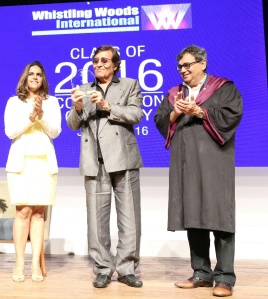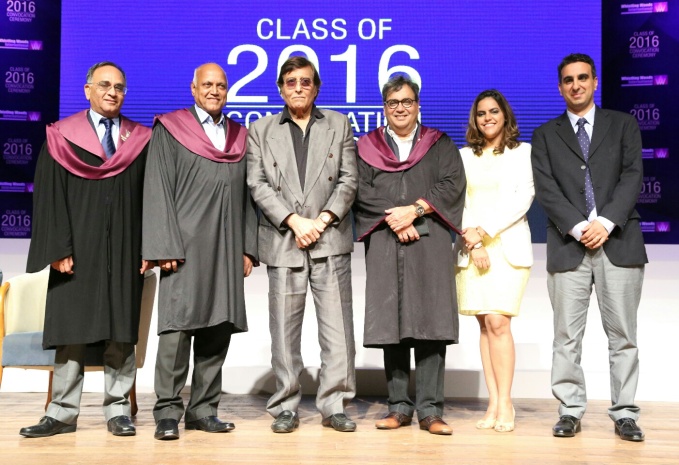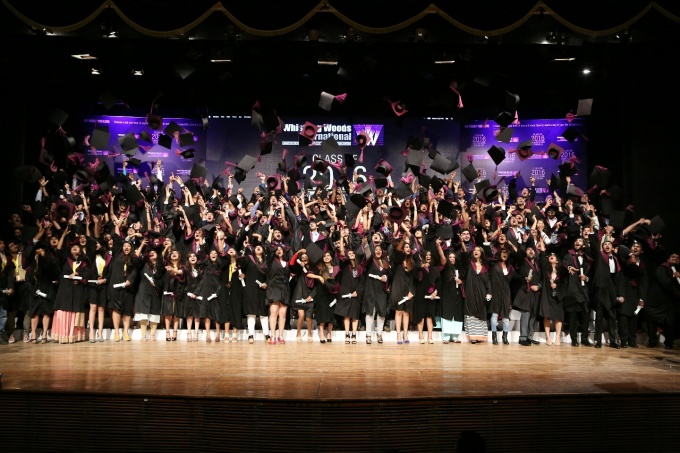We celebrated the 9th Annual Convocation of its 16th & 17th graduating batches on July 18, 2016. The event witnessed a vibrant afternoon with around 1000 people comprising industry professionals, parents of the students and students full of alluring hopes and energy, where their achievements were acknowledged and appreciated with awards and commendations.
 This year, legendary singer, Lata Mangeshkar and acclaimed actor-producer, Vinod Khanna, were conferred with the ‘Whistling Woods Maestro Award’, for their invaluable contribution to Indian cinema. Visionary entrepreneur and multiplex baron, Ajay Bijli, Managing Director and Chairman, PVR Ltd, addressed the students with an inspiring speech as the keynote speaker, sharing his words of wisdom and key entrepreneurial skills.
This year, legendary singer, Lata Mangeshkar and acclaimed actor-producer, Vinod Khanna, were conferred with the ‘Whistling Woods Maestro Award’, for their invaluable contribution to Indian cinema. Visionary entrepreneur and multiplex baron, Ajay Bijli, Managing Director and Chairman, PVR Ltd, addressed the students with an inspiring speech as the keynote speaker, sharing his words of wisdom and key entrepreneurial skills.
The ceremony began with Subhash Ghai, Meghna Ghai Puri, Ravi Gupta, Manmohan Shetty, lighting the lamp, followed by a video demonstrating various milestones achieved by us in a span of 10 years. One of the key highlights of the event was the performance of Aishwarya Majmudar of Kaanchi & Prem Ratan Dhan Payo fame, who left the audience in awe as she rendered some songs of Lata Mangeshkar ji as a tribute to the legendary singer.
 Also seen at the event presenting commendations to students were film director, Amol Gupte, Chairman, Adlabs, Manmohan Shetty, film producer Rajkumar Barjatya, among others.
Also seen at the event presenting commendations to students were film director, Amol Gupte, Chairman, Adlabs, Manmohan Shetty, film producer Rajkumar Barjatya, among others.
“With this graduating batch, we, at Whistling Woods International have accomplished ten successful years. It gives me immense pleasure to share that we have delivered on what we committed when we set out to start the institute in 2006. The constant efforts by Meghna, Rahul, Ravi Gupta and the faculty have been instrumental in shaping the institute and I am honoured to be a part of the fulfilling first decade journey. I wish that legendary personalities like Lata ji, Vinod Khanna and industry stalwarts like Ajay Bijli, continue to inspire us to create more well-honed industry ready professionals and thereby helping students make great careers in a holistic way”, said, Subhash Ghai, Founder & Chairman, Whistling Woods International.

Thanking everyone present at the annual Convocation ceremony, Meghna Ghai Puri, President, Whistling Woods International, said, “It’s a great day today for all of us as we celebrate the graduation day of the 16th & 17th batches of Whistling Woods International at the end of our 10th year of running the institute. Ten years back on the same date we brought in force my father’s long held dream of opening a world-class teaching school for film aspirants in Bombay and today we are recognised as one of the leading film, communication and media arts institute in the country, a sense of achievement for all of us as we gear up to take on the journey for many more decades to come. I congratulate the students and wish them all the very best for their future.”
Now, more than 1100 alumni are successfully working in the Media and Entertainment industry, having bagged prestigious projects in filmmaking, animation and acting. Recent and popular projects, include, Mohenjo Daro, Sultan, Udta Punjab, Kapoor & Sons, Masaan, The Jungle Book, Fan, Neerja, Bajirao Mastani, Bhaag Milkha Bhaag, PK, Highway, Humpty Sharma Ki Dulhania to name a few, as filmmakers in various capacities and Shashank Arora - Titli; Rajshri Deshpande - Angry Indian Goddesses, among others, as actors in prominent roles in critically acclaimed and award winning films.





























